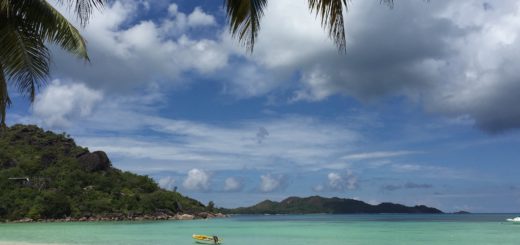Coco de Mer – the unbelievable nut!!

Lodoicea, commonly known as Coco de Mer or sea coconut is a monotypic genus of the palm family but the sole species, Lodoicea Maldivica, is endemic to the Seychelles islands of Praslin and Curieuse.
Before the Seychelles were discovered, nuts of this species were sometimes carried by the ocean currents. When a coco de mer fruit falls into the sea, it cannot float because of its great weight and density. It sinks to the bottom instead. However, after the fruit has been on the sea bed for a considerable period of time, the husk drops off, the internal parts of the nut decay, and the gases that form inside the nut cause the bare nut to rise up to the surface. At that time the nut can float, but is no longer fertile.
The name of the genus, Lodoicea, is derived from Lodoicus, the latin form of Louis, in honour of King Louis XV of France. Other sources say that Lodoicea is from Laodice the daughter of Priam and Hecuba. However, the exceptional size and particular form of the nut, the circumstances of its discovery, and some unusual qualities of the trees have given rise to several legends.
This is not surprising as the nut of the coco de mer has a very strange shape. It is very large (the largest seed in the plant kingdom) with the shape and size of a woman’s disembodied buttocks on one side and a woman’s belly and thighs on the other side. Of the six monospecific endemic palms in Seychelles, Lodoicea is the “only true case of island gigantism among Seychelles flowering plants, a unique feature of Seychelles vegetation”.
It holds five botanical records:
- It produces the largest wild fruit so far recorded, weighing up to 42 kg.
- The mature seeds weighing up to 17.6 kg are the world’s heaviest.
- The seed upon germinating, produces the longest known cotyledon, up to four meters (13 feet).
- The female flowers are the largest of any palm.
- Lodoicea is the most efficient plant known at recovering nutrients from moribund leaves.

The seed of Legends
It is believed that these nuts possess amazing healing powers. In one of his books, Dr. Seemann mentioned that many believed the nuts to be an antidote to all poisons.
These seeds – the largest and heaviest in the world – were once believed to grow on trees beneath the waves of the Indian Ocean and to hold great healing powers. Even when it later turned out that the palm grows on dry land, new folklore develop. In fact it is believed that to produce this seed, the male and female plants embrace each other on a stormy night. According to the legend, male trees uproot themselves, and approach female trees. The love-making trees are rather shy, and the legend has it that whoever sees the trees mating will die or go blind.
In the Victorian Era, General Charles George Gordon, who visited the Seychelles in 1881, believed that the Vallée de Mai on the island of Praslin was the original Garden of Eden as described in the Bible, and that the coco de mer was the forbidden fruit of the tree of the knowledge of good and evil.
Fruits of coco de mer are developed only on female trees. Male trees have long phallic-looking catkins. Exactly how the female flowers – the largest of any palm – are pollinated remains a mystery. They suspect bees are involved, but other researchers think lizards might transfer pollen from the male trees’ 1.5-metre-long, phallic-looking catkins.

Numbers
The tree generally grows to 25–34 m tall. The tallest on record was 186 feet (56.7 meters) in total height. The leaves are fan-shaped, 7–10 m long and 4.5 m wide with a 4 m petiole in mature plants. However, juveniles produce much longer petioles; up to 29′ 6″ (9 meters) or even 33 feet (10 meters).It is dioecious, with separate male and female plants. The male flowers are arranged in a catkins like inflorescence up to 1 m long which continues to produce pollen over a ten-year period. It is also one of the longest living inflorescences known. The mature fruit is 40–50 cm in diameter and weighs 15–30 kg, and contains the largest seed in the plant kingdom. The fruit requires 6–7 years to mature and a further two years to germinate.





